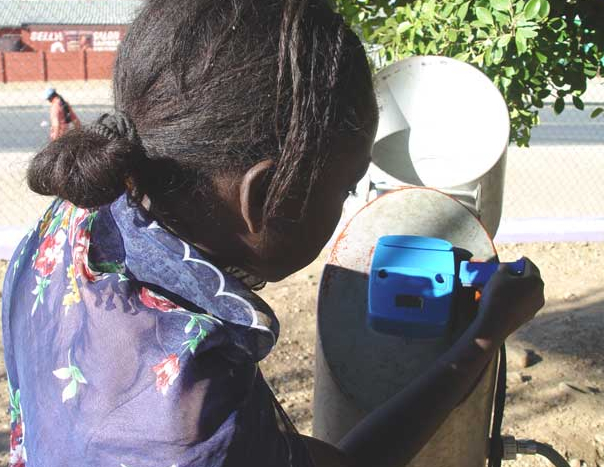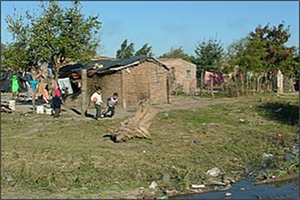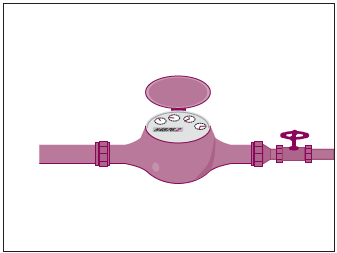Domestic water meter



Water meters, in combination with public standposts or domestic connections, provide the means to charge fees according to the volume of water delivered, and to regulate water use via tariffs. Water meters consist of a device to measure flow, and a protective housing with an inlet and an outlet. A strainer over the inlet keeps larger particles out of the system. There are many types of water meter, but for ordinary domestic or public standpipe use, turbine meters are most common. The vane wheel and the counting device of a water meter can be coupled magnetically or directly. Magnetic coupling has the advantage that the counting device can be completely sealed and no water, silt or algae will get in. A shut-off valve is normally installed on both sides of the meter to allow for servicing.
Flow range: 0.005–1.5 litres for domestic use.
Suitable conditions
Area of use: Piped public water distribution systems.
Construction, operations and maintenance
Manufacturers: Biesinger; Bosco; Kent; Schlumberger; Spanner Pollux; Valmet; TagMeter, etc.
On a regular basis (e.g. every month), the water meter should be read by an appointed person who writes down the new meter count in a book. The difference between two readings of the same meter is the amount of water used, and consumers will be billed accordingly. The reader must check that the meter is in good condition and has not been tampered with. Meter counts can also serve to regulate consumption, by raising tariffs as more water is used. The fee for a meter reader increases the operational costs of the system, but the costs may be partly offset because the domestic water meters (and distribution network water meters) help to control leaks and the wasting of water.
When the water is free of silt, a good-quality water meter needs very little maintenance; however, a specialized workshop is needed for repairs. It is advisable to clean the strainer at least once a year, depending on the meter and water quality. When the meter no longer functions well, it should be replaced or recalibrated. Water meters lose accuracy with time, and about every five years a meter should be cleaned and recalibrated regardless of its status (defined according to the nature of the water and the meter type).
To recalibrate it, the meter should be sent to a specialized workshop for inspection, repair and calibration. A water meter is often owned by the water users themselves, who guarantee that it is treated well. Even when the external parts of a water meter belong to a water committee or project, the users may still be responsible for the condition of the parts. A water committee will need to keep a stock of water meters for replacing defective ones. To reduce costs, the number of different models should be kept to a minimum.
Potential problems
— the meter may become inaccurate, tampered with, stolen, damaged by cattle, or damaged by grit in the water;
— grit or soft debris may clog the strainer;
— the initial cost and operational costs of a water meter are relatively high;
— domestic water meters should not be used with water with a high silt load;
— some meter counters are more difficult to read than others, which can be a problem for both user and meter reader, and may require good skills on the part of the reader.
Costs
Initial cost: From US$ 10–25 or more, not including installation costs.
Field experiences
The following projects utilize domestic water meters.
 MWA-LAP: Honduras |
 MWA-LAP: Guatemala |
 Water for poor areas: Villa Ocampo |
Manuals, videos and links
- Commercial: Prepaid residential meter, domestic meter, household meter. Tagmeter Systems
Acknowledgements
- Brikke, François, and Bredero, Maarten. Linking technology choice with operation and maintenance in the context of community water supply and sanitation: A reference document for planners and project staff. World Health Organization and IRC Water and Sanitation Centre. Geneva, Switzerland 2003.
